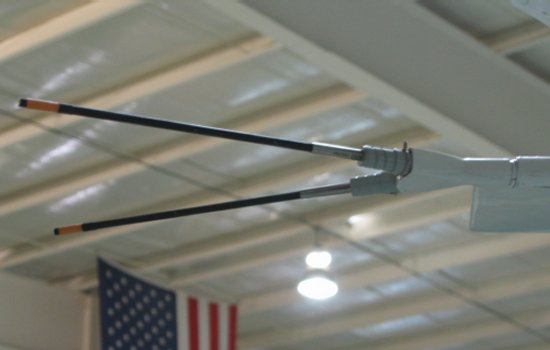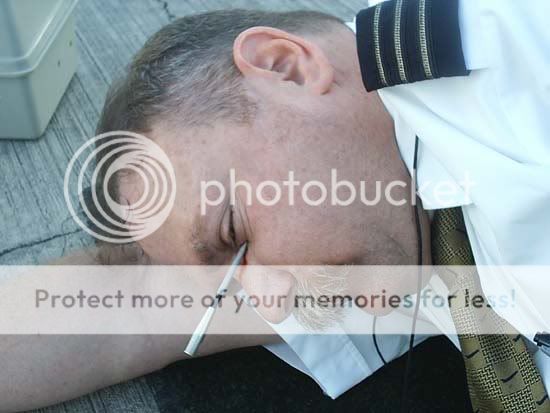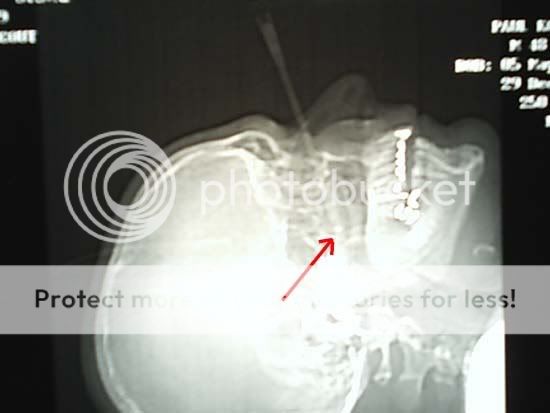| المجموعات الإجتماعية |
| البحث |
| مشاركات اليوم |
 |
| السلامة التقنية للطائرات يهتم بجوانب السلامة الفنية للافراد والطائرات وطرق الصيانة الامنة وتحوطات الامان |
| إضافة رد |
|
|
أدوات الموضوع |
 |
| السلامة التقنية للطائرات يهتم بجوانب السلامة الفنية للافراد والطائرات وطرق الصيانة الامنة وتحوطات الامان |
| إضافة رد |
|
|
أدوات الموضوع |
| مشاركة [ 1 ] | ||||
|
||||
|
|
بسم الله الرحمن الرحيم اود ان اتكلم اليوم عن شيئ مهم جدا في الطائرة وهو مفرغات الشحنات الساكنة STATIC DISCHARGERS Static dischargers are commonly known as static wicks or static discharge wicks. They are used on aircraft to allow the continuous satisfactory operation of onboard navigation and radio communication systems. During adverse charging conditions (air friction), they limit the potential static buildup on the aircraft and control interference generated by static charge. Static dischargers are not lightning arrestors and do not reduce or increase the likelihood of an aircraft being struck by lightning. Static dischargers are subject to damage or significant changes in electrical resistance as a result of lightning strike to the aircraft, and should be inspected after a lightning strike to ensure proper static discharge operation. Static dischargers are fabricated with a wick of wire or a conductive element on one end, which provides a continuous low resistance discharge path between the aircraft and the air. They are attached on some aircraft to the trailing edges of (electrically grounded*) ailerons, elevators, rudder, wing, horizontal and vertical stabilizer tips. On smaller aircraft static dischargers are typically constructed out of glass-reinforced resin surrounding a woven metal conductor. These are fragile and easily damaged by inattentive operators.  A portion of a static discharger on an aircraft. Note the two sharp 3/8" metal micro points and the protective yellow plastic.  Static discharge rods A320 wingtip and static discharge wicks  a pair of static discharge wicks Note: They should be checked on a walk around as they are very susceptible to damage from lightning strikes.
|
|||
|
|

|
| مشاركة [ 2 ] | |||
|
|||
|
عضو خط الطيران
|
موضوع جميل
شكرا لك اخي المحترم |
||
|
|

|
| مشاركة [ 3 ] | ||||
|
||||
|
|
مشكور أخي الكريم علي هذا الموضوع الرائع وأستسمحك بهذة الأضافة
The purpose of static discharge wicks is to dissipate the static electricity that builds up on planes in flight. Most of us are familiar with static electricity in our daily lives. Common examples include the static cling in fabrics after being removed from a clothes dryer and the shock you may feel after rubbing your feet on thick carpeting or after stepping out of a car. Perhaps the most powerful example of static electricity is a bolt of lightning. Static electricity is created when objects with different electrical properties come into contact, and negatively charged electrons from one substance are transferred to the other. This electron imbalance causes the object losing electrons to become positively charged while the other becomes negatively charged. The transfer of electrons is often aided by friction when two objects rub together, such as rubbing a balloon against your hair that causes hair to stand up. The same effect occurs on an aircraft due to the friction against the plane as it moves through the air. This friction strips electrons from the atmosphere and causes them to build up on the skin of the aircraft. The creation of static charges is largely dependent on the ability of the two substances to conduct electricity. Metals are good conductors and allow electrons to flow freely through them. Other materials like rubber and air tend to be good insulators since they conduct electricity poorly. However, the ability of a substance to conduct electricity can also vary significantly with conditions. Air, for example, is typically a much better insulator at higher altitudes where aircraft fly because the atmospheric conditions here are much less humid than at low altitudes. As a result, a static charge that builds up on an aircraft at high altitude tends to become much larger because the air acts as an insulator preventing the excess electrons from returning back to the air. This electrical charge can eventually become so great that the excess electrons begin to ionize local air particles and create a corona around parts of the plane. This corona causes electrons to discharge back into the surrounding air and dissipates the charge on the aircraft. Unfortunately, the coronal discharge most often forms on surfaces like communication and navigation antennas that transmit and receive radio waves. This ionized corona causes interference that reduces the effectiveness of communication gear or blocks reception entirely. NASA research has indicated that the interference typically occurs over a range of frequencies between 10 kHz and 350 MHz where most radios and other communication gear operate. An extreme example of ionizing interference occurs during re-antry when a spacecraft's high speed causes such intense friction against the atmosphere that the surrounding air is turned into ionized plasma and communications are lost for several minutes. The static charges that build up on an aircraft during flight tend to accumulate near sharp edges like the trailing edges of wings and tail surfaces. The purpose of static wicks is to provide a conductive path for these excess electrons to flow or "leak" from the aircraft back into the atmosphere. This transfer of electrons reduces the charge on the plane's skin and structure. The wicks are composed of hundreds of individual carbon fibers wrapped into a cylinder around three to eight inches (7.6 to 20.3 cm) long and about the diameter of a soda straw. Each fiber ends in a sharp point to create a strong gradient in the local electrical field. This gradient attracts the static charge and encourages the electrons to flow off the aircraft and back into the atmosphere. Instead of an ionized corona building up on vital communication antennas, the electrical charges find these wicks more attractive. Static discharge wicks also provide other important safety benefits. In the event of a lightning strike, a plane is designed to conduct the excess electricity through its skin and structure to the wicks to be safely discharged back into the atmosphere. Though this massive electrical charge often burns or melts the wicks, these devices are simple and easy to replace. Wicks are also relatively fragile and easy to damage, so pilots and ground crew routinely inspect them in case replacement is needed. Because of their importance, regulatory agencies like the Federal Aviation Administration (FAA) require static wicks aboard all civil aircraft. |
|||
|
|

|
| مشاركة [ 4 ] | ||||
|
||||
|
|
شكرا علي الاضافة
|
|||
|
|

|
| مشاركة [ 5 ] | ||||
|
||||
|
|
شكرا لك أخي على هذا الموضوع
|
|||
|
|

|
| مشاركة [ 6 ] | ||||
|
||||
|
|
العفو و مشكور جدا اخي رامز علي المرور
    
|
|||
|
|

|
| مشاركة [ 7 ] | ||||
|
||||
|
|
شكرا للكابتن علي وللكابتن طارق على الموضوع المفيد جدا حبذا لو يتم اضافة شيء ولو مختصر باللغة العربية لتعم الفائدة واسمحوا لي ان اضيف الى وجوب وضع شارة حمراء يمكن ان تكون قطعة قماش حمراء في اطراف الاجنحة للتنبيه عن وجود هذه المفرغات لتنيه المارة من الفنيين لان هذه المفرغات عادة ما تكون قريبة من راس المار ومحاذاته خصوصا وانها ذات راس مدبب حاد قابل للايذاء وقابل للكسر والانحراف بسهولة ولذلك يجب وضع شارة التنبيه هذه منعا لحصول ضرر للمارين وللطائرة وقد حصل مثل هذا في خطوط الطيران وفي الصيانات ( وفي بعض الطائرات توجد اغطية مخصصة لمثل هذه الحافات المدببة الحادة يجب التاكد من وجودها ) بارك الله فيكم اخواني تقبلوا تحياتي
|
|||
|
|

|
| مشاركة [ 8 ] | ||||
|
||||
|
|
حياكم الله جميعاً الرجاء الإطلاع على الموضوع التالي ماذا تعرف عن الكهرباء الساكنة في الطائرة......؟؟؟؟ تحياتي للجميع mechanic |
|||
|
|

|
| مشاركة [ 9 ] | ||||
|
||||
|
|
شكرا لك اخي عماد و رايك في محله اد يجب وضع اغطية معينه لمفرغات الشحنات الساكنة (static wicks covers) لحماية المهندسين و الطيارين واي شخص اخر يتجول بالقرب من الطائرة كما ما حصل لهذا الطيار اترككم مع الصور.......................................
  اغطية مفرغات الشحنات الساكنة (STATIC wicks convers) الطيار المصاب ...................     و في الختام نتمني السلامة للجميع ودمتم سالمين     |
|||
|
|

|
| مشاركة [ 10 ] | ||||
|
||||
|
|
عجيب!!!!! كيف دخلت في رأس الطيار؟؟ رغم انها موجودة في الأجنحة والذيل أرائكم ياشباب |
|||
|
|

|
| مشاركة [ 11 ] | ||||
|
||||
|
|
موضوع جميل شكرا لك اخي المحترم العفو اخي shock wave |
|||
|
|

|
| مشاركة [ 12 ] | |||
|
|||
|
كابتن طيار
|
هل فقد البصر ؟ الله يستر :( :( :( :( .. وشلون دخلت في رأس الطيار ؟
|
||
|
|

|